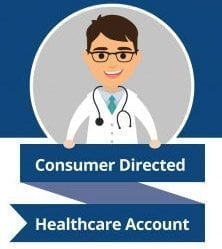The infographic below details the value of consumer-directed healthcare accounts. Learn more from this overview of HSAs, HRAs, FSAs, and other helpful information.

What is a Consumer Directed Healthcare Account?
A consumer-directed healthcare (CDH) account is a type of medical savings account that:
- Helps pay for eligible medical expenses
- Offered through an employer (or, in the case of HSAs, can also be set up by an individual)
- Gives account holders more control over healthcare dollars
There are three primary types of CDH accounts: Health Savings Accounts (HSAs), Health Reimbursement Arrangements (HRAs), and Flexible Spending Accounts (FSAs).
HSAs
The participant owns the HSA, which acts like a regular bank account. Money deposited into the account can be used to pay (or reimburse the account owner) for eligible healthcare expenses, including deductibles, co-pays, and coinsurance.
- You must have an HSA-qualified high-deductible health plan (HDHP) to open or contribute to an HSA – although if you later change to a non-qualified plan, you can continue using HSA account funds in the same manner as if you were actively contributing
- Funds used or withdrawn for medical expenses are not subject to taxes and IRS penalties
- Unspent funds roll over to the following year with no limit
- Accounts funds earn tax-free interest
- Funds used for non-medical expenses are subject to taxes and IRS penalties
- All contributions are tax-deductible
- Maximum pre-tax contributions for 2024 are $4,150 for self-only coverage, $8,300 for family (age 55 or over can contribute an additional $1,000)
HRAs
In an employer-owned HRA, the employer funds employee accounts to help them pay for qualified medical expenses, including deductibles, co-pays, and coinsurance.
- HRAs can be paired with any health insurance plan
- The employer decides which IRS-qualified expenses are eligible
- There is no mandated limit on the size of the employer’s contribution
- HRAs cannot pay for monthly health insurance premiums unless they are one of two HRA types created specifically for that purpose (ICHRAs and QSEHRAs)
- The employer has the option of rolling over any unused funds to the next plan year
FSAs
A healthcare FSA allows the account holder to set aside pre-tax money to pay for eligible healthcare costs throughout the year. The employer owns the plan, but the account holder decides how much money to put into it.
- Maximum pre-tax contributions for 2024 is $3,200.
- FSA funds can pay for a wide variety of medical, dental, and vision care expenses.
- FSA funds can pay for deductibles, copays, coinsurance, and similar expenses but not premiums
- FSAs lower your income taxes by using pre-tax money
- Employers can contribute to your FSA, but it’s not a requirement
CDH Plans See Steady Growth
As of 2023, over two-thirds of all large employers (1000+ employees) offer an HSA-eligible plan.* This continues a 10-year pattern of steady growth in the percentage of large employers who offer HSA-eligible health plans. Growth in the percentage of large employers with CDH plans:
- 2014 – 45%
- 2015 – 52%
- 2016 – 57%
- 2017 – 58%
- 2018 – 64%
- 2019 – 62%
- 2020 – 67%
- 2021 – 66%
- 2022 – 66%
- 2023 – 69%
*Source: Kaiser/HRET Survey of Employer-Sponsored Health Benefits, 2005-2017; KFF Employer Health Benefits Survey, 2018-2021
CDH Health Plan Advantages for Employers
- Reduce current healthcare plan costs
- Help limit future increases in plan costs
- Employee retention tool
CDH Health Plan Advantages for Employees
- Lower healthcare plan premiums
- Reduce income taxes through pre-tax funding directly from payroll
- Tax-free funds for medical expenses (and in the case of HSA funds, for retirement as well)
Who Should Use a CDH Plan?
CDH plans usually offer low monthly premiums, high deductibles, and limits on out-of-pocket expenses. They work well for people who:
- Want low monthly premiums
- Seek to reduce tax burdens
- Plan and track medical expenses effectively


